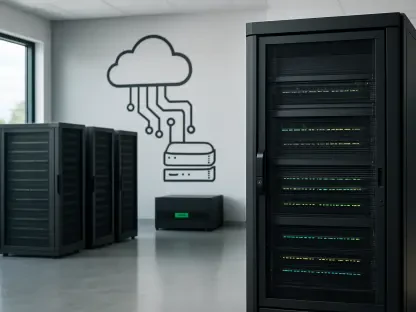Cloud computing has revolutionized the way organizations operate, offering unparalleled flexibility and scalability. However, it has also introduced new security challenges. Traditional security models, once seen as robust, are now inadequate for the dynamic and distributed nature of cloud environments. As businesses increasingly adopt cloud solutions to foster innovation and efficiency, there is an urgent need to evaluate and enhance security mechanisms to safeguard sensitive data and critical assets from evolving threats.
The Evolution of Cloud Security
Traditional Security Models
Traditional security models were akin to fortresses, relying heavily on perimeter defenses to protect organizational resources. These models assumed that everything inside the firewall was trustworthy, which is no longer applicable in the cloud era. With the explosion of cloud-based services, these perimeter defenses have become outdated, as they cannot adequately account for the distributed and decentralized nature of cloud environments. The static nature of earlier security frameworks leaves organizations vulnerable to sophisticated cyber-attacks that exploit the inherent weaknesses in perimeter-based security.
Corporate networks today are no longer confined to a single geographical location, rendering traditional security models obsolete. Employees and assets are dispersed across various locations and devices, accessing cloud resources from potentially unsafe networks. This drastic shift necessitates a security approach capable of adapting to the fluidity of modern cloud infrastructures. The previous reliance on perimeter defenses fails to address the complexities of ensuring secure access and data protection in such expansive, interconnected environments.
Inadequacies of VPNs
Virtual Private Networks (VPNs) are part of these outdated systems. VPNs provide broad access once a user gains entry, making them vulnerable to breaches. This lack of granular control poses significant risks in cloud environments. The principle that once authenticated, a user can navigate the network with relatively unrestricted access is fundamentally flawed in today’s cloud-centric operations. Once inside, unauthorized users can potentially access sensitive data or execute malicious activities without facing stringent checks.
Moreover, VPNs fail to provide comprehensive visibility and control over user activities within the network. They lack the mechanisms to enforce strict access controls and monitor user behaviors, leading to a higher risk of insider threats and lateral movement by attackers. This broad access allowance hinders the ability to detect and respond to suspicious activities promptly, making VPNs ill-suited for the dynamic security needs of cloud environments. As a result, organizations are increasingly recognizing the necessity to transition from VPNs to more sophisticated, granular control models.
The Rise of Zero Trust Network Access (ZTNA)
Principles of ZTNA
Zero Trust Network Access operates on the “never trust, always verify” principle. It mandates continuous verification of every user and device attempting to access cloud applications and data, irrespective of their location. This approach significantly enhances security by ensuring strict authentication and authorization protocols are in place before granting access. Unlike traditional models, ZTNA does not assume any user or device is inherently trustworthy based on their location within the network perimeter; instead, each interaction undergoes rigorous scrutiny.
The constant verification process encompasses various layers of security, including the application of multi-factor authentication (MFA), behavior analytics, and risk assessments. By doing so, ZTNA mitigates risks associated with compromised credentials and unauthorized access. Furthermore, its dynamic nature allows for real-time assessments and responses, ensuring that access permissions are continuously aligned with the changing security landscape. This adaptability is crucial for maintaining robust security in the ever-evolving cloud environment, where threats are not static and security needs to be agile and responsive.
Least Privilege Access
ZTNA enforces the least privilege access, ensuring that users only have the permissions necessary to perform their tasks. This minimizes the potential damage from compromised accounts or systems. By strictly limiting access rights, ZTNA reduces the scope of what an adversary can exploit if they manage to infiltrate the network. Users and devices are given minimal permissions, substantially lowering the likelihood of abuse or accidental exposure of sensitive information.
Implementing least privilege access also aids in preventing lateral movement within the network. If a user’s credentials are compromised, the attacker is confined to a minimal set of actions and resources, making it difficult to cause extensive harm. This principle ensures that security breaches are contained and easier to detect and resolve. The meticulous management of access rights further reinforces the security posture, providing a safeguard against both external threats and insider risks. Organizations thereby achieve a more resilient and controlled environment, essential for maintaining the integrity and confidentiality of their cloud-based operations.
Enhanced Security through Micro-Segmentation
Importance of Micro-Segmentation
Micro-segmentation is a critical feature of ZTNA. It involves dividing the cloud environment into smaller segments, each with its own security controls, thereby limiting the lateral movement of attackers. By partitioning the cloud network into isolated segments, organizations can apply unique security policies and manage each segment independently, reducing the attack surface. This segmentation ensures that even if one part of the network is compromised, the breach does not easily extend to other areas, containing the potential damage.
Moreover, micro-segmentation allows for precise control over data flows within the cloud. Security policies can be tailored to each segment’s specific requirements, enhancing the protection of sensitive data and critical applications. This creates a multilayered defense mechanism where security measures are duplicated across numerous small sections rather than relying on a single, overarching defense strategy. In doing so, organizations can better safeguard their cloud ecosystems from sophisticated cyber threats, ensuring robust security configurations are consistently enforced across all segments.
Continuous Monitoring
ZTNA requires ongoing monitoring of all activities within the cloud environment. This continuous evaluation helps in quickly identifying and responding to any suspicious behavior, enhancing the overall security posture. Continuous monitoring is pivotal for maintaining real-time insights into user activities and potential security threats. By constantly overseeing interactions and transactions within the cloud, organizations can swiftly detect anomalies and unauthorized actions, allowing for immediate intervention.
Robust logging and analytics capabilities enabled by continuous monitoring contribute to a proactive rather than reactive security stance. Administrators can analyze patterns, flag suspicious activities, and take preemptive measures to safeguard against potential breaches. The real-time nature of this approach ensures that security protocols are always up-to-date, adapting swiftly to new threat vectors. Overall, continuous monitoring underpins the ZTNA framework, reinforcing it with a vigilant layer of scrutiny that is essential for maintaining the integrity and security of cloud environments.
Future-Proofing Cloud Security
Resilience Against Evolving Threats
The dynamic nature of cloud computing requires a security framework that can adapt to evolving threats. ZTNA provides this resilience, offering a robust alternative to static perimeter-based models. The agility of ZTNA allows organizations to continuously refine and strengthen their security posture in response to emerging threats. Its adaptive nature ensures that security measures are always in line with the latest threat intelligence, providing robust protection against a diverse array of cyber threats.
Integrating ZTNA into cloud security strategies equips organizations with the tools necessary to defend against sophisticated attacks that target cloud infrastructures. The principle of continuous verification and least privilege access, combined with micro-segmentation and comprehensive monitoring, creates a multi-layered defense mechanism that is more responsive to changes in the threat landscape. This proactive approach to security ensures that cloud resources are consistently protected, significantly reducing the risk of breaches and unauthorized access.
Adoption and Implementation
Cloud computing has transformed how businesses operate, providing unmatched flexibility and scalability. While these advancements are impressive, they come with new security issues that can’t be ignored. Traditional security systems, once deemed reliable, fall short in addressing the evolving and dispersed nature of cloud environments. As companies increasingly turn to cloud technologies to drive innovation and improve efficiency, there’s an urgent need to reassess and upgrade security measures. Protecting sensitive data and critical resources from emerging threats has never been more crucial. Ensuring robust security protocols in cloud computing environments is essential for any organization’s long-term success and stability. This wouldn’t just safeguard confidential information but also help maintain customer trust, which is paramount in this digital age. Therefore, organizations must proactively address these security challenges and work towards creating stronger, more resilient cloud security frameworks.









